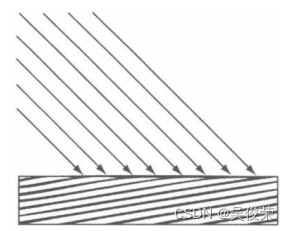Direct3D 12——灯光——平行光

平行光源(parallel light)也称方向光源(directional light,也译作定向光源),是一种距离目标物体 极远的光源。因此,我们就可以将这种光源发出的所有入射光看作是彼此平行的光线。再者, 由于光源距物体十分遥远,我们就能忽略距离所带来的影响,而仅指定照射到场景中光线的光强(light intensity )。

我们用向量来定义平行光源,借此即可指定光线传播的方向。因为这些光线是相互平行的,所以采 用相同的方向向量代之。而光向量与光线传播的方向正相反。可以准确模拟出方向光的常见光源实例是 太阳

实现
//代替菲涅尔方程的石里克近似。此函数基于光向量L于表面法线n之间的夹角,并根据菲涅尔效应近似地计算出以n为法线的表面所反射光的百分比
// Schlick gives an approximation to Fresnel reflectance (see pg. 233 "Real-Time Rendering 3rd Ed.").
// R0 = ( (n-1)/(n+1) )^2, where n is the index of refraction.
float3 SchlickFresnel(float3 R0, float3 normal, float3 lightVec)
{float cosIncidentAngle = saturate(dot(normal, lightVec));float f0 = 1.0f - cosIncidentAngle;float3 reflectPercent = R0 + (1.0f - R0)*(f0*f0*f0*f0*f0);return reflectPercent;
}//计算反射到观察者眼中的光量,该值为漫反射光量于镜面反射光量的总和
float3 BlinnPhong(float3 lightStrength, float3 lightVec, float3 normal, float3 toEye, Material mat)
{//m由光泽度推导而来,而光泽度则根据粗糙度求得const float m = mat.Shininess * 256.0f;float3 halfVec = normalize(toEye + lightVec);float roughnessFactor = (m + 8.0f)*pow(max(dot(halfVec, normal), 0.0f), m) / 8.0f;float3 fresnelFactor = SchlickFresnel(mat.FresnelR0, halfVec, lightVec);float3 specAlbedo = fresnelFactor*roughnessFactor;//尽管我们进行的是LDR(low dynamic range .低动态范围)渲染,但spec(镜面反射)公式得到// 的结果仍会超出范围[0,1],因此现将其按比例缩小一些// Our spec formula goes outside [0,1] range, but we are // doing LDR rendering. So scale it down a bit.specAlbedo = specAlbedo / (specAlbedo + 1.0f);return (mat.DiffuseAlbedo.rgb + specAlbedo) * lightStrength;
}//平行光(方向光)
float3 ComputeDirectionalLight(Light L, Material mat, float3 normal, float3 toEye)
{//光向量与光线传播的方向刚好相反float3 lightVec = -L.Direction;//通过朗伯余弦定律按比例降低光强float ndotl = max(dot(lightVec, normal), 0.0f);float3 lightStrength = L.Strength * ndotl;return BlinnPhong(lightStrength, lightVec, normal, toEye, mat);
}

